News Details
August 2025

operator neo
The ESA SSA-NEO Coordination Centre has released the August newsletter summarising the most relevant data and events on asteroids and comets approaching the orbit of the Earth. Please, feel free to forward it to potentially interested people.
You can download the newsletter by clicking on the button below. To subscribe to the service, please fill in the form on page: https://neo.ssa.esa.int/subscribe-to-services.
EU-ESA Workshop on Astrometric and Radar Observations of NEOs

operator neo
The European Commission and ESA’s Planetary Defence Office together are organising the “EU–ESA Workshop on Astrometric and Radar Observations of Near-Earth Objects” on 6–8 October 2025 at the European Space Research Institute (ESRIN) in Frascati, Italy.
The meeting's purpose is to gather the asteroid community to discuss how we can improve the quality and reliability of astrometric and radar observations of near-Earth objects, with a particular focus on orbit determination and uncertainty modelling. During this workshop, we will review how astrometric uncertainties—both positional and timing—are currently treated, examine the mathematical and practical approaches for their estimation, and assess how they propagate into orbital solutions. Special emphasis will be placed on synthetic tracking, emerging detector technologies, and the integration of radar data into orbit determination workflows. Current and potential future radar European capabilities will also be discussed.
By convening the community, we aim to formulate suggestions, guidelines, and actions for improving the robustness of observational data used for planetary defence. The goal is to ensure that, should a hazardous object be detected on a possible collision course with Earth, we can rely on high-quality astrometric and radar data for timely and accurate impact risk assessments.
A link to the event web portal can be found here.
The workshop sessions are the following:
- Orbit determination and uncertainty propagation
- Astrometric observations and timing precision
- Radar observations and integration in astrometric pipelines
- Synthetic tracking and AI-based techniques
- Non-traditional astrometry: occultations, Gaia, and space-based assets
- Prospects for future radar facilities
Workshop presentations have been organised by invitation of relevant speakers. Speakers and interested participants are invited to register to the event up to 30 September 2025. Ample slots have been allocated in the programme to allow discussions between the experts. A limited number of presentation slots are still available. If a workshop attendee considers having a relevant contribution in the subject and would like to present it at the workshop, please send a message to the organisers with a proposed title and abstract (maximum of 300 words) before 15 August 2025. The workshop will be hybrid, with local and remote attendance possible. A limited capacity of up to 40 people will be available for local attendance to the event. These will be available to the speakers wanting to attend in person and on a first come, first served for the rest of attendees.
NEO coordination and big data

neo admin
An interesting connection between Earth Observation and NEO monitoring activities has been unveiled through the NEO Coordination Centre participation at the "Big Data From Space" meeting, held at ESRIN from 5 to 7 june 2013 (http://www.congrexprojects.com/2013-events/13c10/programme).
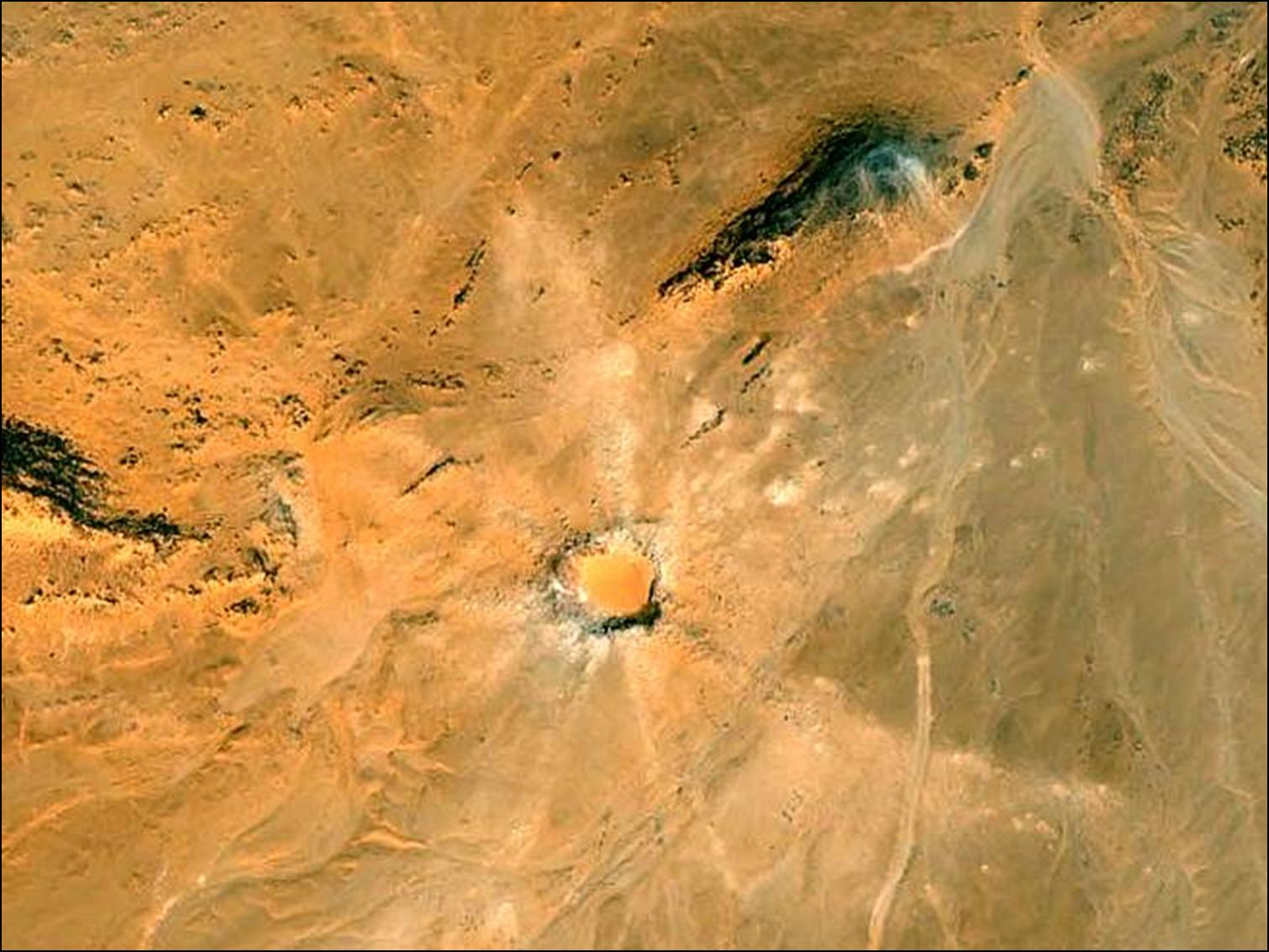
The meeting aims to timely face the challenge of the huge increase in the images flow coming from space which will characterise the next generation of Earth Observation missions. The study case presented by the NEOCC refers to the discovery and characterization of the Kamil crater, a rayed impact crater with 45 m in diameter located in southern Egypt and first identified on Google Earth in 2008.
A geophysical expedition was undertaken in February 2010, which collected several hundred kilograms of nickel-enriched iron meteorites and performed in-situ measurements.
Prior to the expedition extensive analysis of the impact site was performed by both high resolution optical images and by radar acquisitions from the Italian COSMO-SkyMed satellites (on the left - The Kamil crater floor depth is 16 m and is overlain by a 6 m-thick crater-fill material, which is consistent with a crater generated by an iron meteorite 1.3 m in diameter impacting at a velocity between 3 and 4 km/s. QuickBird Image 2009, Courtesy of Telespazio.), allowing detailed geo-morphological analysis of the features surrounding the crater and the search for secondary impacts.
The possibility of setting up an extended survey of small impact craters in inaccessible regions by using multispectral high resolution images appears then an appealing opportunity and a novel application within the "Big Data" initiative.
The utilisation of Earth Observation data for developing and implementing new services at the NEO Coordination Centre and their contribution to operations has been also discussed.
An unexpected very close approach

neo admin
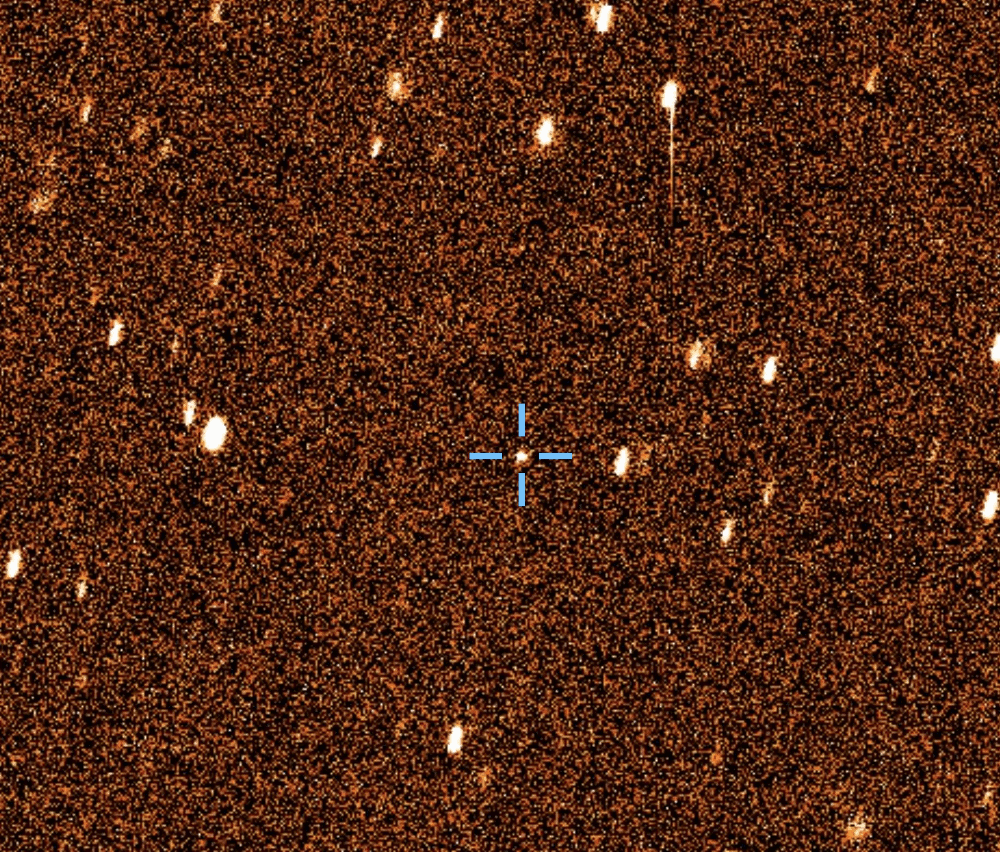
Exposure animation for asteroid 2020 HS7 as observed by the Tautenburg Observatory on 28 April 2020, a few hours after the Pan-STARRS project reported the discovery.
Credit: ESA / Tautenburg Observatory, S. Melnikov, C. Hoegner, B. Stecklum
On the evening of 27 April (European time), the NASA-funded Pan-STARRS project in Hawaii reported observations of a new asteroid, temporarily labelled P20ZIf8, collected with their second survey telescope over a timespan of less than an hour during the previous observing night. These observations immediately showed that the object was extremely close to our planet, and had a ~10% probability of being on a collision course, heading for a possible impact the following day.
This circumstance attracted the attention of many observers worldwide. Less than 50 minutes after the initial report by Pan-STARRS, the Xingming Observatory in China obtained the first follow-up astrometry, followed about an hour later by one of our collaborators, the Tautenburg observatory in Germany, which we had alerted asking for immediate observations. With this data, it became clear that the object was not going to collide with the Earth, but it was heading towards a very close fly-by the following day, roughly at the distance of Earth's geostationary orbit (although ~10° below it). The object was just a few metres in size, and therefore it would not have caused any significant threat even if it had been on a collision course. It had nevertheless been an interesting exercise to test the discovery and rapid follow-up capabilities of worldwide observers. Subsequent astrometry, obtained by additional collaborators of our Centre and by many other observatories worldwide, is sufficient to determine that the flyby happened on 28 April at about 18:49:40 UTC, and at a distance of about 42 745 km from the Earth centre. These numbers can be determined with a precision of just a few kilometres and a few seconds, showing that the trajectory of a nearby object can be established with exquisite accuracy even with just a day of data, if good observational coverage can be obtained.
The fly-by of this asteroid, now named 2020 HS7, ranks among the 50 closest ever recorded. Interestingly, the fly-by happened only 15 hours before the closest approach of (52768) 1998 OR2, a much larger kilometre-sized object that attracted the attention of the worldwide media. However, this latter object only approached our planet 16 times farther than the Moon (more than 6 million kilometres away), while 2020 HS7 came significantly closer to us and likely represented a more significant event for the astronomical community.
For further information please consult this ESA news.
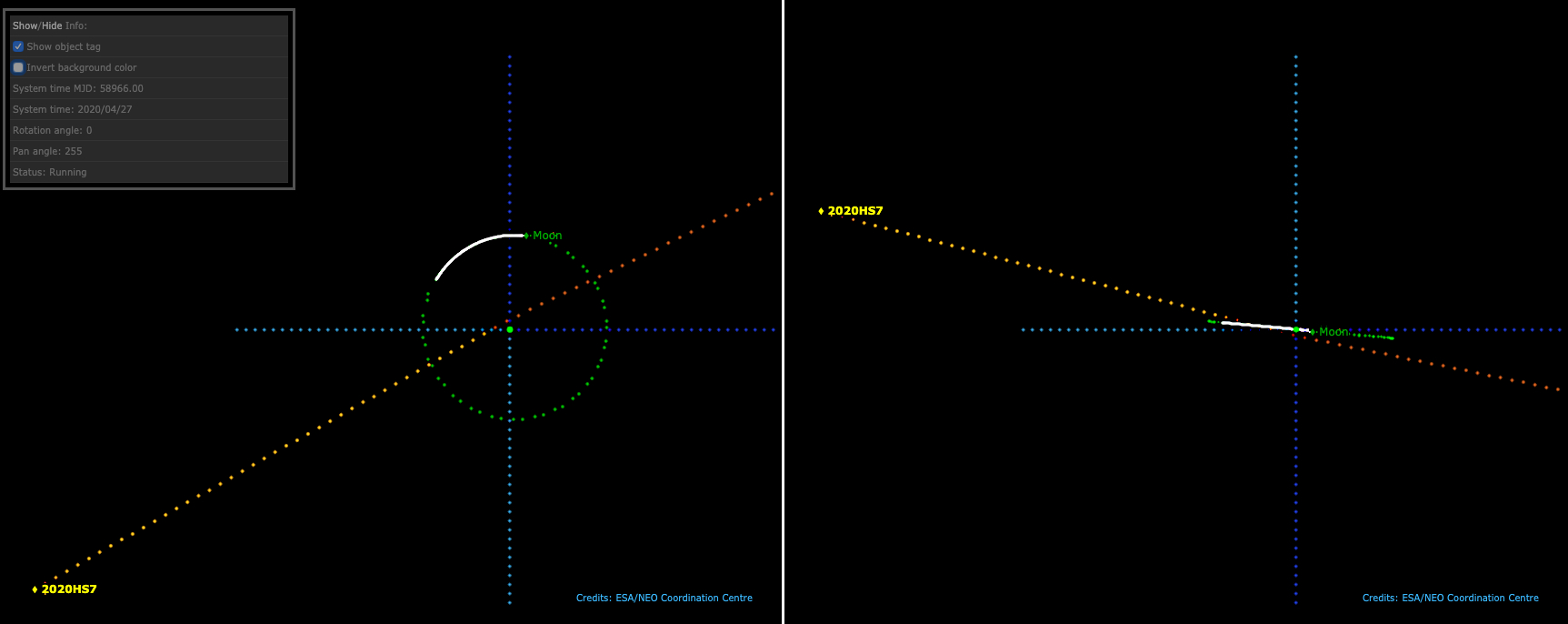
New NELIOTA project detects flashes from lunar impacts

neo admin
Using a system developed under an ESA contract, the Greek NELIOTA project has begun to detect flashes of light caused by small pieces of rock striking the Moon's surface. NELIOTA is the first system that can determine the temperature of these impact flashes.
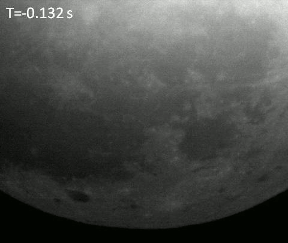
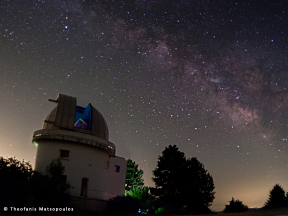
Lunar impact flash. Credit: NELIOTA project (left panel). Kryoneri Observatory, Greece. (right panel). Credit: Theofanis Matsopoulos
Studies such as NELIOTA are important because Earth and its Moon are constantly bombarded by natural space debris. Most of this material ranges in size from dust particles to small pebbles, although larger objects can appear, unexpectedly, from time to time. This was the case when an object almost 20 m in diameter disintegrated above the Russian city of Chelyabinsk in February 2013. The resultant explosion, caught on camera, caused considerable damage, although, fortunately, no one was killed.
Particles only millimetres across usually appear several times per hour on any clear dark night in the form of meteors or 'shooting stars'. However, the number of incoming objects in the size range from decimetres to metres is not well known. Too small to be detected directly with telescopes, they are rarely captured by cameras when they enter Earth's atmosphere.
One way to determine the number of larger impactors and the potential impact threat to Earth is to observe the Moon, in particular the dark area not illuminated by the Sun. When small asteroids strike the lunar surface at high speed, they burn up on impact, generating a brief flash of light, which can be visible from Earth. Assuming a typical velocity and density, the size and mass of the object can be estimated from the brightness of the event.
A new campaign to study these lunar flashes is being undertaken by the NELIOTA (Near-Earth object Lunar Impacts and Optical TrAnsients) project, which began operation on 8 March 2017. NELIOTA utilises a refurbished telescope, which is operated by the National Observatory of Athens and located close to the Greek town of Kryoneri.
The 1.2 m telescope splits incoming light into two colours and uses two advanced digital cameras to record the data at a rate of 30 frames per second. Observations of the Moon's night hemisphere are made whenever Earth's natural satellite is above the horizon and mainly dark – between New Moon and the first quarter phase, or between last quarter and New Moon.
Automated software analyses the video obtained and identifies possible impact flashes. Camera effects can be excluded by identifying events that are only visible in both cameras. The cameras operate in different colour ranges, allowing the temperature of the impact flash to be estimated – NELIOTA is the first system of this type to have the potential to determine the temperature of these flashes.
The exceptional capability of the telescope was confirmed during its pre-operational, commissioning phase, when it recorded four impact flashes in about 11 hours of observing time. The task is now to observe these flashes on the dark side of the Moon over a period of 22 months.
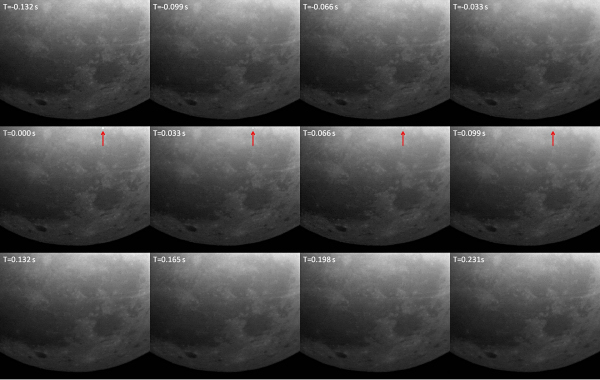
"Its large telescope aperture enables NELIOTA to detect fainter flashes than other lunar monitoring surveys and provides precise colour information not currently available from other projects", says Alceste Bonanos, the Principal Investigator for NELIOTA.
"Our twin camera system allows us to confirm lunar impact events with a single telescope, something that has not been done before. Once data have been collected over the 22-month long operational period, we will be able to better constrain the number of NEOs (near-Earth objects) in the decimetre to metre size range."
"The data will also help to determine the physics of impact flashes. We are analysing the flashes in collaboration with the Science Support Office of ESA, in order to measure the temperature of each flash and estimate the mass, size of the impactor and crater size created from the impact."
Lunar impact flash. Credit: NELIOTA project
"These observations are very relevant for our Space Situational Awareness programme. In particular, in the size range we can observe here, the number of objects is not very well known. Performing these observations over a longer period of time will help us to better understand this number", says Detlef Koschny, co-manager of the near-Earth object segment in ESA's Space Situational Awareness programme, and a scientist in the Science Support Office.
NELIOTA is also contributing to public outreach and education.
"We are currently training two PhD students to operate the Kryoneri telescope and conduct lunar monitoring observations", says Alceste.
"We also organise public tours of Kryoneri Observatory, during which we present the NELIOTA project, as well as talks on near-Earth asteroids for students and for the general public. This year, we plan to participate in Asteroid Day 2017, by organising a public event at Kryoneri Observatory on 30 June."
BACKGROUND INFORMATION
The National Observatory of Athens developed and operates NELIOTA. It is funded through a contract with ESA's Science Directorate.
The NELIOTA website (http://neliota.astro.noa.gr/) provides the observational characteristics of the flashes (time, duration, magnitude, coordinates) within 24 hours of the observations.
Following its upgrade in 2016 for the NELIOTA project, the Kryoneri telescope is mainly used for lunar monitoring. It is also contributing to follow-up photometry of transient events, such as those detected by ESA's Gaia mission, as well as asteroid occultations.
One of the dangers humans on the Moon would face is that a small asteroid could damage their infrastructure – NELIOTA will help estimate the danger from such small asteroids. As the Moon doesn't have an atmosphere, it cannot block the smaller – but still dangerous – objects. It is likely that permanent structures on the Moon will be underground, to provide better shielding from both small asteroids or meteoroids and solar radiation.
CONTACTS
Alceste Bonanos, NELIOTA Principal Investigator
Institute for Astronomy, Astrophysics, Space Applications and Remote Sensing
National Observatory of Athens
Greece
Phone: +30 210 8109177
Email: bonanos@astro.noa.gr
Detlef Koschny, SSA-NEO co-manager
Directorate of Science
European Space Agency
Email: Detlef.Koschny@esa.int
Vicente Navarro, NELIOTA Technical Officer
Directorate of Science
European Space Agency
Email: Vicente.Navarro@esa.int
Fireball over The Netherlands

neo admin
A bright fireball occurred over The Netherlands on 21 September 2017 at 19:00 UTC (21:00 CEST). In addition to many individual sightings, it was also recorded by an all-sky camera dedicated to recording exactly such events. The camera is part of the Fireball Recovery and InterPlanetary Observation (FRIPON) network (https://www.fripon.org), and is hosted on the roof of a building at ESA's ESTEC technical centre in Noordwijk, The Netherlands.
Other FRIPON cameras which recorded the event were located in Lille and Brussels. The combined data will allow to the object's trajectory to be reconstructed. It is most likely that any resulting fragments – meteorites – will have fallen into the North Sea.
Fireball sightings such as this can be reported to the International Meteor Organisation (http://www.imo.net) or to the American Meteor Society (http://www.amsmeteors.org). Reports for this particular fireball can be seen via https://www.amsmeteors.org/members/imo_view/event/2017/3301.
The ESTEC FRIPON camera was funded by the ESTEC Science Faculty.
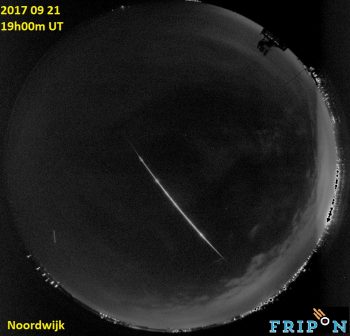
A bright fireball occurred over The Netherlands on 21 Sep at 19:00 UTC (21:00 CEST). Credit: ESA/D. Koschny/A. Toni/FRIPON team.
2018 LA, the third predicted NEO impact on Earth

neo admin
For the third time in recent history of asteroid detection a NEO was detected a few hours before it entered the Earth atmosphere (the two previous cases were 2008 TC3 and 2014 AA).
Asteroid 2018 LA was discovered by the Catalina Sky Survey in the early morning (European time) of this Saturday, 2 June.
In a matter of hours additional observations were made and it became very probable that it would collide with the Earth. The approximate impact corridor was over a thin stripe crossing Botswana and Namibia. The same evening a number of local observations started to arrive at the International Meteor Organisation reporting a very bright fireball detected in the mentioned area. It was confirmed that the observed fireball actually corresponded to 2018 LA. Details about the observed fireball can be found here: https://www.imo.net/asteroid-2018-la-hit-the-atmosphere-over-botswana-on-june-2/
The object had a size of 2 to 5 m and approached the Earth with a relative velocity of approximately 17 km/s from the night side. Due to its small size and high entry velocity the object could only be detected on its final plunge to Earth. It is expected to have completely disintegrated in the atmosphere.
Discovery images of 2018 LA obtained on 2 June 2018 with the 1.5 m telescope at Mt. Lemmon, Arizona (USA). Credit: Catalina Sky Survey / University of Arizona / NASA
Call for media: ESA hosts IAA Planetary Defence Conference 2015

neo admin
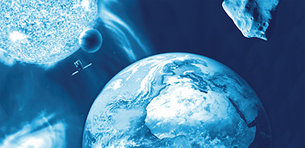
Assessing the threat
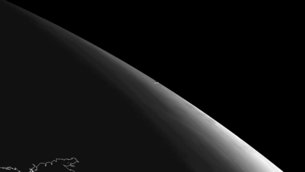
Coordinating Europe's efforts
Press briefing 16 April
Programme:
CREOP Room, Building 11, ESRIN
| 10:00 | Doors open; registration |
| 10:30 |
The Planetary Defence Conference: Global cooperation against asteroid threats
Dr Detlef Koschny, Head of NEO Segment, ESA Space Situational Awareness Programme
|
| 10:45 |
Finding asteroids & avoiding impacts: space agencies taking action to prevent future catastrophe
Dr Lindley Johnston, NEO Programs Executive, Science Mission Directorate, HQ NASA
|
| 11:00 |
Responding to asteroid threat scenarios - The importance of impact simulation exercises
Debbie Lewis, Director, Resilience Planning at Axiom (Alderney) Ltd.
|
| 11:15 |
Presentation of findings PDC 2015
Dr William Ailor, Distinguished Engineer, The Aerospace Corporation, PDC 2015 co-chair
Richard Tremayne-Smith, Advisor, The Secure World Foundation, PDC 2015 co-chair
|
| 11:45 | Open Q&A |
| 12:00 |
End of briefing; opportunities for individual interviews; small group visits to ESA's NEO Coordination Centre
|
Registration
Contact
Tel.: +33 1 47 23 82 15
ESA's planetary defence test set for 2020

neo admin
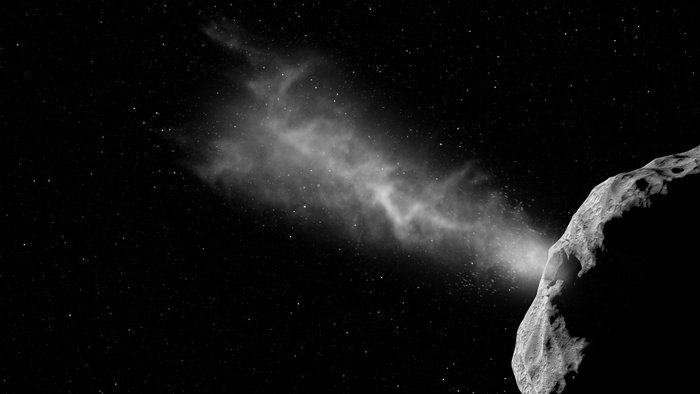
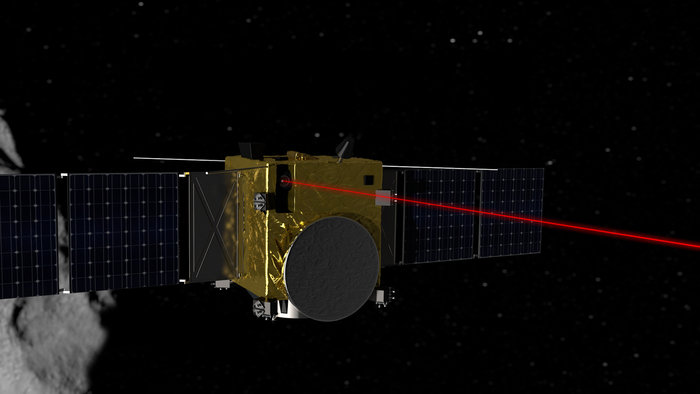
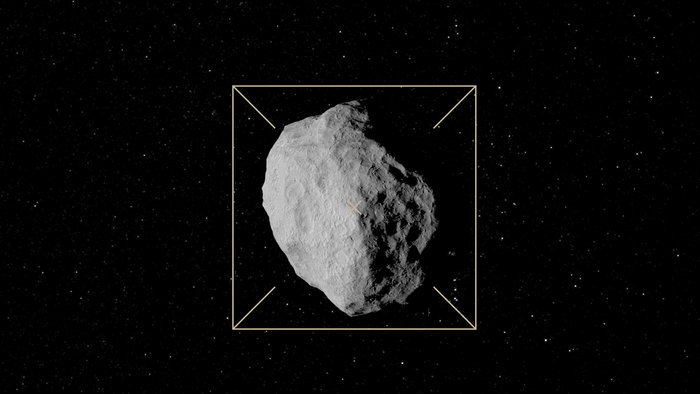
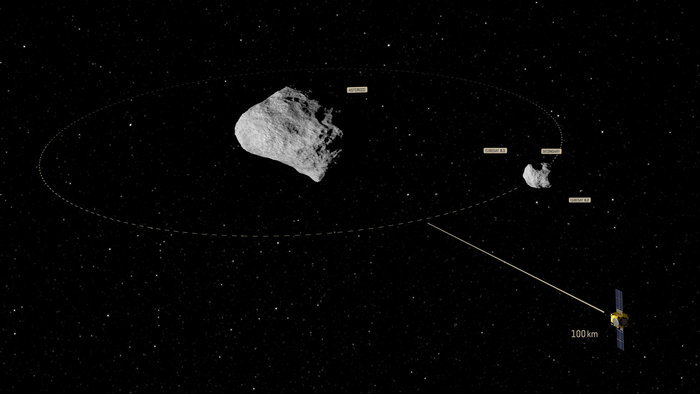
2014 UR116 is no threat

neo admin
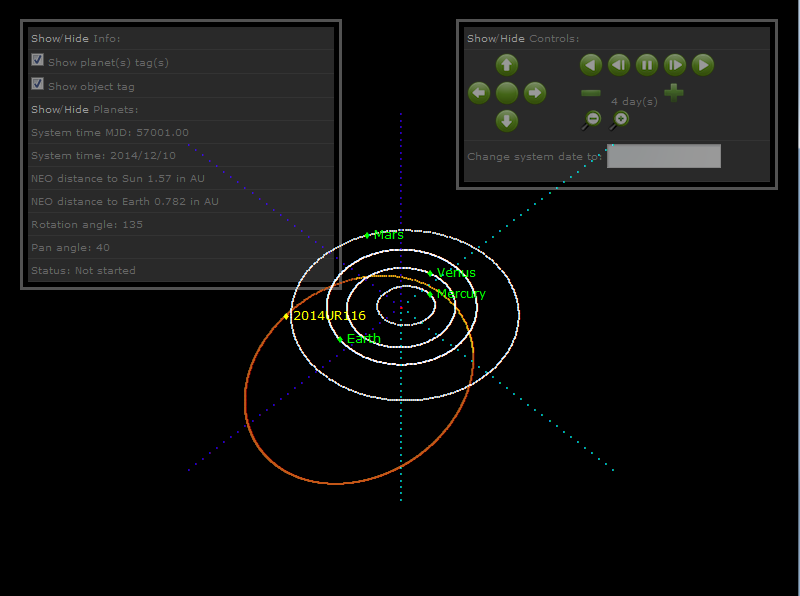
LBT detects one of the faintest NEOs ever observed thanks to a collaboration between INAF and ESA

neo admin
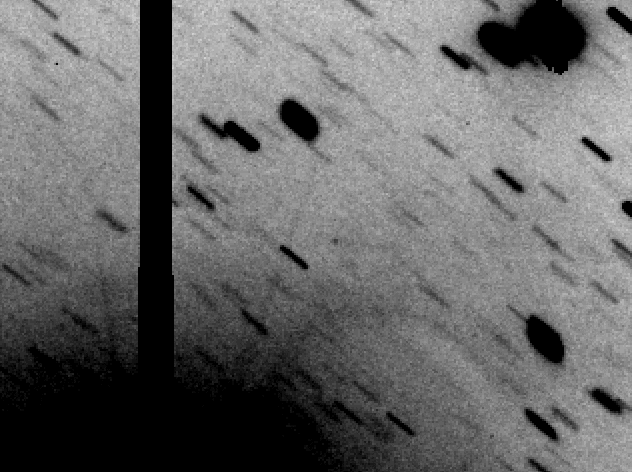
The Large Binocular Telescope (LBT), of which the Italian National Institute for Astrophysics (INAF) is a main partner, has successfully observed asteroid 2014 KC46 in one of the faintest Near-Earth Object (NEO) recoveries ever performed. This challenging observation, which pushed the limits of the telescope down to a visual magnitude of 26.3, was carried out on the nights of 28 and 30 October 2014 by a new collaboration between the Italian LBT team and the NEO Coordination Centre of the European Space Agency.
LBT spotted the 100-metre-sized object while it was just beyond the orbit of Mars. The corresponding measurement of its position was sufficient to decrease the uncertainties associated to its orbital path to the point of safely dismissing any possible threat that the asteroid may hit the Earth in the near future.
The successful observation of 2014 KC46 has been made possible by the unique performances of LBT: a large field of view to entirely cover the uncertainty in the position of the target asteroid, coupled with the ability to spot very faint objects thanks to the twin 8.4-meter mirrors of the telescope. This result highlights the importance of rapid response for securing NEO orbits and the effectiveness of LBT in detecting faint large-uncertainty objects.
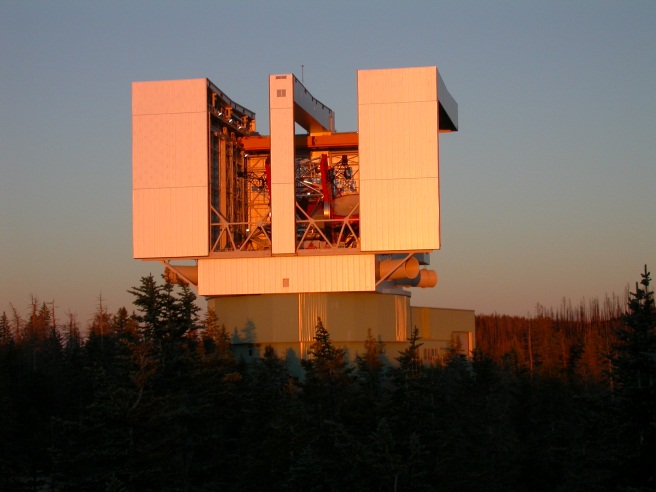
The data have been accepted by the IAU Minor Planet Center, the official organisation in charge of collecting astrometric data for small bodies of the solar system, and published in the electronic circular MPEC 2014-V35. Both the European NEODyS system and the JPL-based Sentry system updated their orbit determination and impact monitoring using the new LBT observations, and confirmed the removal of all impact solutions for the next century.
The Large Binocular Telescope is a facility consisting of two 8.4-meter mirrors on a common mount, located at an altitude of 3200 m on Mt. Graham (Arizona, USA). This telescope is equivalent in light-gathering power to a single 11.8 meter instrument.
LBT is a collaboration between the Instituto Nazionale di Astrofisica (INAF), The University of Arizona, Arizona State University, Northern Arizona University, the LBT Beteiligungsgesellschaft in Germany, The Ohio State University, Research Corporation in Tucson, and the University of Notre Dame.
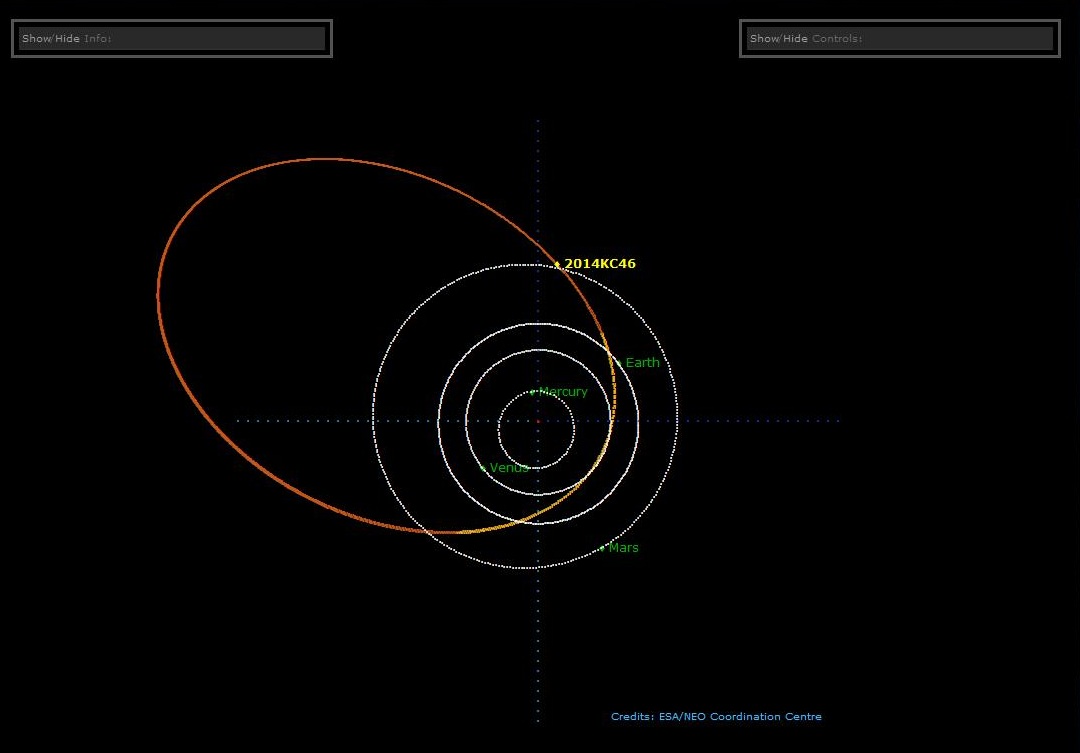
The NEO Segment of ESA's Space Situational Awareness (SSA) aims to coordinate and combine information from different sources, analyse them to predict possible impact with the Earth, assess danger, and analyse possible mitigations, including the deflection of a menacing asteroid.
Within this framework, the ESA NEO Coordination Centre provides data and services on the NEO hazard and coordinates follow-up astronomical observations.
Final presentation day at ESRIN - Computing the risk of NEOs, impact scenarios, the future of NEO activities, and more

neo admin
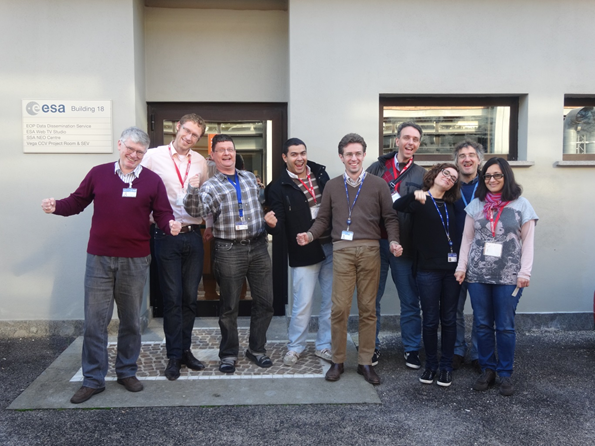
Getting ready for asteroids

neo admin
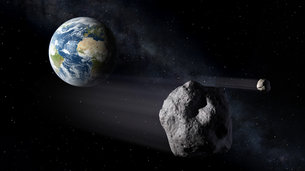
With a mandate from the UN, ESA and other space agencies from around the world are about to establish a high-level group to help coordinate global response should a threatening asteroid ever be found heading towards Earth.
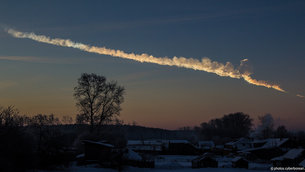
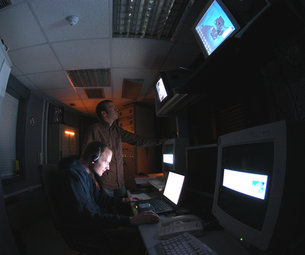
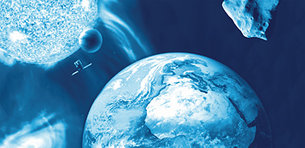
Happy birthday, NEAS!

neo admin
The number of known Near-Earth Asteroids has just overcome 10,000 units! This result represents an important achievement if one thinks that over the one hundred years between 1898 (when the first NEA, 433 Eros was discovered) and 1998 only about 500 NEAs had been found, while the current NEA discovery rate is about 1,000 per year.
Out of the 10,000 discoveries, roughly 10 percent are larger than one kilometer in size, while the vast majority of NEAs are smaller than that, with the number of objects of a given size quickly increasing as the size decreases.
The first and most important step to protect our planet from NEAs is to discover all objects potentially at risk of collision with the Earth and in doing so the present wide-field, high-sensitivity sky surveys have proven extremely effective, putting astronomers are on the right track.
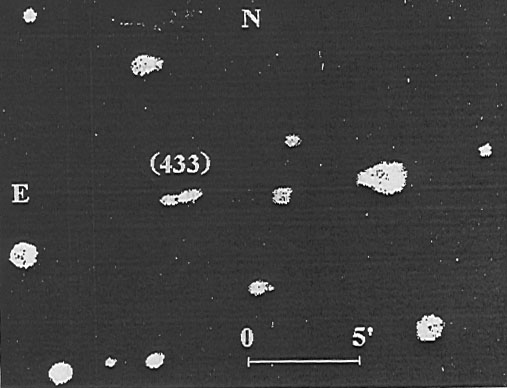
The elongated track left by 433 Eros is clearly visible in the discovery plate of the first NEA taken by Gustav Witt from the Observatory of Berlin. More details on the story behind Eros discovery at http://spaceguard.iaps.inaf.it/tumblingstone/issues/num20/eng/eros.htm
TOTAS survey finds its first comet

neo admin
In a fruitful collaboration between ESA and a group of amateur astronomers, the first comet was discovered by the so-called TOTAS survey. The comet is called P/2014 C1 (TOTAS) and has an orbit between Jupiter and Mars.
TOTAS stands for 'Tenerife Observatory Teide Asteroid Survey'. The survey name is derived from the name SOHAS = Starkenburg Observatory Heppenheim Asteroid Survey. SOHAS was initiated by M. Busch, a software developer and active amateur astronomer at the public observatory in Heppenheim, Germany (called Starkenburg-Sternwarte). Already in 2009, M. Busch adapted his telescope control and asteroid search software to work with the 1-m telescope of ESA on Tenerife, the Optical Ground Station, and renamed it TOTAS.

When the SSA-NEO programme learned about this, a long and fruitful collaboration started in March 2010. During a survey test campaign very close to the morning horizon on 01 February 2014, the automatic processing software picked up a special object. R. Reszelewski, one of the team of amateur astronomers who check the images generated by the computer software, was the first to detect the cometary nature (on the left - Animation of the comet; Image credit: TOTAS/ESA).
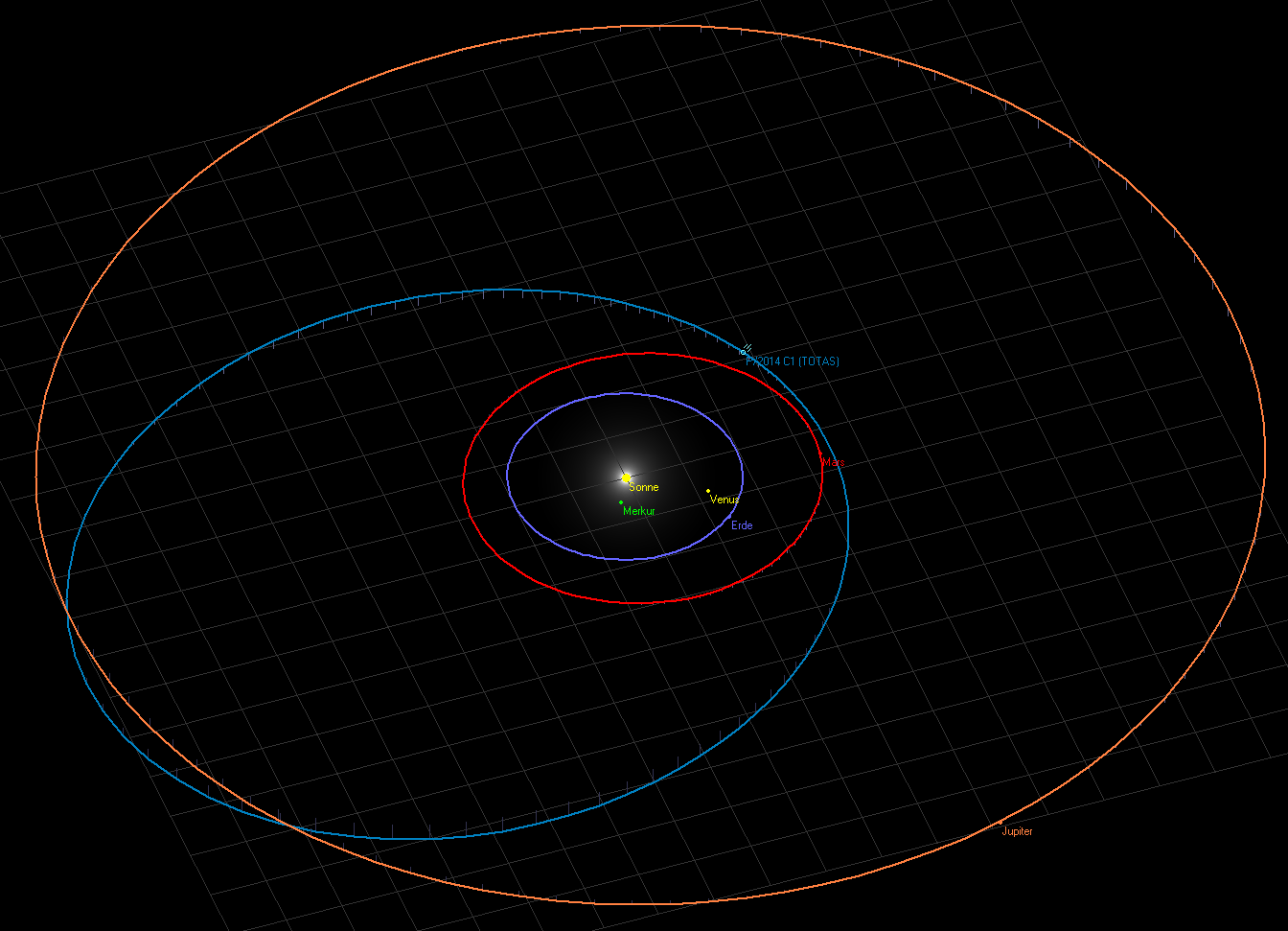
The observations were immediately submitted to the Minor Planet Center. On 04 February, after confirming messages of eight other observatories securing the orbit, the Minor Planet Center announced the discovery of comet TOTAS (http://www.minorplanetcenter.net/mpec/K14/K14C11.html.
The comet orbits the Sun between Jupiter and Mars and will not come close to the Earth. Its orbit is shown in the figure on the right: Comet P/2014 C1 (TOTAS) orbit (Image credit: M. Busch/EasySky).
Happy Birthday NEOCC!

neo admin
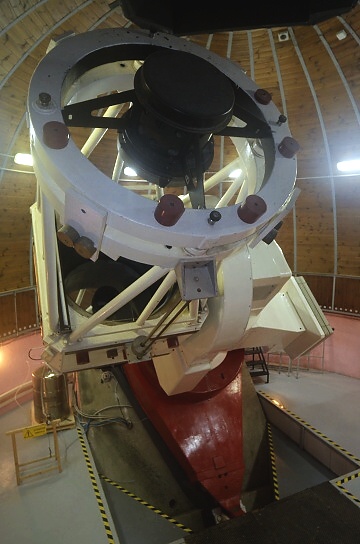
Today the NEO Coordination Centre (NEOCC) celebrates its first year of activities. On 22 May 2013 the Centre was formally inaugurated at ESRIN by Thomas Reiter, ESA Director of Human Spaceflight and Operations.
Since then, the Centre has regularly provided information and data on NEOs through its main services updated on a daily basis (Risk list, Priority list, Close Approaches and Physical Properties) and through its technical news service.
In addition, several campaigns for astrometric and physical observations of NEAs have been organized and successfully completed. A network of collaborating observatories has been created (on the left - The AZT-24 Telescope at Campo Imperatore Station used for infrared observations of NEAs; Image credit: INAF).
A good example for an astrometric and physical observation campaign was the case of 2013 QW1, a candidate NEO in an Earth-bound orbit whose nature, either natural or artificial, needed to be quickly determined. An observingalert triggered by the NEOCC resulted in rapid spectroscopic observations from the 3.5 meter Italian Telescopio Nazionale Galileo (TNG) in the Canary Islands, which contributed to exclude that 2013 QW1 was a natural object because of the ìartificialî appearance of its reflectance spectrum. We acknowledge Davide Perna, Antonella Barucci (Observatoire de Paris Meudon) and Elisabetta Dotto (INAF ñ Osservatorio di Roma) for having responded to our call.
The observing campaign of 2002 GT fits along the second type of activities done by the NEOCC, namley to coordinate observations.. The observing campaignwas organised by the Centre to characterise the target selected for the NASA EPOXI (formerly Deep Impact) mission during its last apparition before the then planned encounter with the spacecraft. A large community promptly responded: photometric and light-curve observations were performed from the 1-metre diameter C2PU telescope at the Observatoire de la Cote d'Azur, which allowed the calculation of the rotation period of the object (3.77 hours).
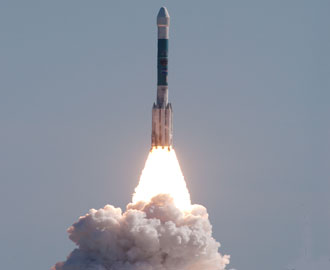
Building up on these early experiences, a framework agreement with ESO's Very Large Telescope (VLT) has been established, which has allowed the Centre to start a focused observational effort to obtain astrometric observations of high-risk objects.

This collaboration allowed the NEOCC team to obtain critical observations of almost a dozen dangerous objects, which in most cases led to their removal from the list of possible future impactors; a few recent examples have been the early recovery of 2009 FD (currently the highest-rated known possible impactor) and the challenging follow-up observations of 2014 AF16.
The regular availability of the ESA Optical Ground Station (OGS) Telescope for ESAís NEO programme turned out to be extremely useful to perform routine observations of newly discovered objects, with a specific focus on the urgent targets suggested by the NEOCC Priority List.
The Centre keeps growing. The technical and scientific team behind the NEOCC is working on the implementation of new services and on the improvement of the existing ones, which will be soon available ( on the left - The ESA Optical Ground Station (OGS); Image credit: ESA). Meanwhile, a well-timed gift is already on the way for celebrating the second birthday of the NEOCC: the 4th IAA Planetary Defence Conference will be hosted at ESA/ESRIN on 13 - 17 April 2015. See you then!
External links:
ESA/ESO Collaboration Successfully Tracks Its First Potentially Threatening Near-Earth Object. ESO Announcement, 21 January 2014. http://www.eso.org/public/announcements/ann14004/
Target Asteroid Tracked by European Teams. ESA SSA News, 18 July 2013. http://www.esa.int/Our_Activities/Operations/Space_Situational_Awareness/Target_asteroid_tracked_by_European_teams
Space Oddity: The Mystery of 2013 QW1. ESA SSA News, 19 September 2013. http://www.esa.int/Our_Activities/Operations/Space_Situational_Awareness/Space_oddity_the_mystery_of_2013_QW1
Publications related to NEOCC activities:
E. Perozzi, D. Koschny, R. Dominguez-Gonzalez, G. Drolshagen, N. Sanchez-Ortiz. The SSA NEO Segment and Gaia: present opportunities and future developments. In proc. '2nd Gaia-Follow-Up Network for Solar System Objects'. P. Tanga and W. Thuillot eds. IMCCE/Observatoire de Paris, 2013.
E. Perozzi. The Near Earth Object Hazard and Mitigation. In proc. 'Mathematical Methods for Planet Earth'. A. Celletti, U. Locatelli, E. Strickland eds, Springer. 2013 (in press).
E. Perozzi, F. Bernardi, A. Milani, G.B. Valsecchi. "Vicini ma non troppo". Le Scienze, July 2013.
E.Perozzi, F. Bernardi, E. Foschi, G. Drolshagen, D. Koschny, G.B. Valsecchi: Observing small and accessible NEOs: the importance of newly discovered objects. Stardust Virtual Workshop, Glasgow 6-9 May 2014.
2014 RC - a close fly-by coming up

neo admin

Target asteroid tracked by european teams

neo admin
In a recent close-ish flyby, asteroid 2002 GT was studied in detail for the first time by a network of European astronomers. The observations were coordinated by ESA's asteroid centre in Italy, and should prove crucial for a future spacecraft rendezvous.
Asteroid 2002 GT, a relatively large object a few hundred metres across, made a somewhat close flyby of Earth on 26 June, passing us at almost 50 times the distance of the Moon.
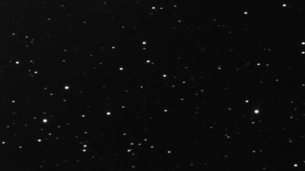
The encounter sparked intensive worldwide observations because the asteroid is the target of NASA's Epoxi mission in January 2020.
Last month's flyby was the last chance before then to study the object's diameter, rotation, composition and other physical characteristics (on top - Asteroid 2002GT passes Earth 26 June 2013; More about this video).
Ideal opportunity to coordinate response
"The flyby presented an ideal opportunity to exercise the unique ‘coordinating function' of ESA's new Near-Earth Object Coordination Centre," says Ettore Perozzi, project leader for NEO services at Deimos Space.
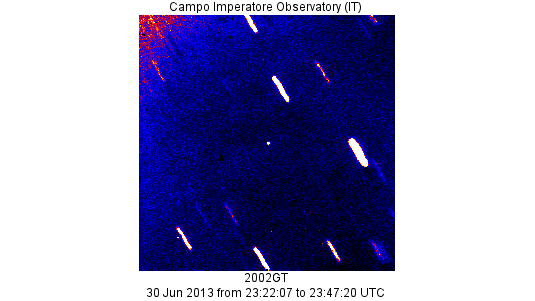
"By alerting and then collating observations from diverse European teams, the Centre was able to provide a comprehensive set of results back to the scientific and space exploration communities, a cycle that wasn't happening before. This is really a first for Europe."
Deimos Space leads a project team that operates the Centre at the Agency's ESRIN site near Rome.
The gathered information will enable a very good characterisation of the asteroid's surface composition, thermal properties, shape and rotation. All of these features are crucial for any spacecraft visit.
Moreover, analysis of its changing brightness indicates the possible presence of a small moon.
Focal point: ESA's NEO Coordination Centre
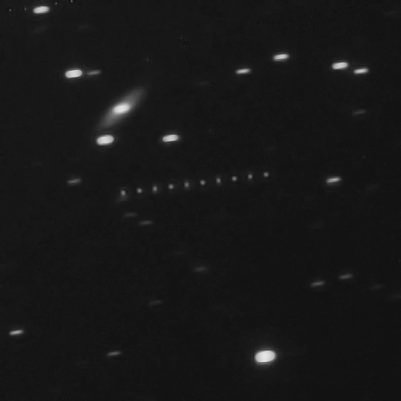
Gerhard Drolshagen, co-manager of the NEO segment at ESA's Space Situational Awareness programme office, says the 2002 GT (below in the image) event highlighted the potential coordination role that the Centre can play in addition to its primary function of providing information on all known NEOs, including their orbits, impact risk and close approaches to Earth.
"Traditionally, Europe's asteroid community reliably delivered world-class observations and has been credited with many significant discoveries and findings. What was lacking, however, was a central point to coordinate and synthesise data that could function across national and organisational boundaries.
"Our Centre has proven it can act as a driving force and a focal point for the European and international community involved in asteroid science, impact monitoring and mitigation."
Ettore adds: "We now know 2002 GT is a rocky body, belonging to a peculiar transition class that astronomers refer to as ‘Sq-type'.
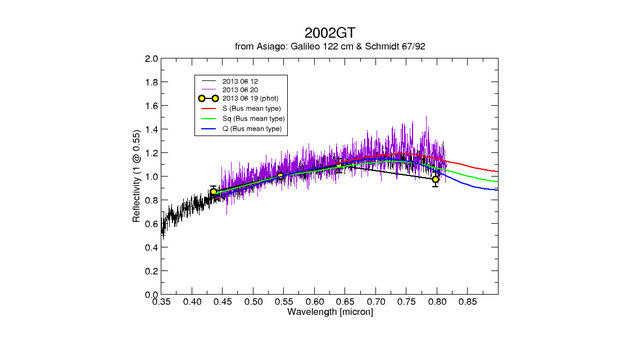
"It's also a potentially hazardous object, as its orbit crosses that of Earth, so it's certainly a very interesting object, well worth watching."
More about the NEO Coordination Centre, SSA and contact information
About 2002GT observations
ESA's Near-Earth Object Coordination Centre (NEO-CC) received well-documented observations of 2002GT as follows:
- Photometry and light-curve data from the 1 m-diameter C2PU telescope at the Observatoire de la Cote d'Azur, which allows calculation of the rotation period (3.77 hours). The shape of the light curve is also compatible with the presence of a satellite.
- Spectra and photometric data from Asiago Observatory (University of Padova and Observatory of Padova) which allows determination of the asteroid type (Sq), in agreement with other observations.
- Infrared observations from the Campo Imperatore Station of the INAF Rome Astronomical Observatory. Even under bad weather conditions, teams there were able to spot the asteroid 20 days before Earth flyby.
- Astrometry from Gaia-FUN-SSO. Six telescopes observed 2002 GT providing more than 1000 astrometric measurements. These were sent to the Minor Planet Centre and processed at the Institut de Mécanique Céléste et de Calcul des Ephémérides for computing orbital elements.
Comet ISON: recent observations of an approaching body

neo admin
A new series of images from Gemini Observatory shows Comet C/2012 S1 (ISON) heading toward an extremely close rendezvous with the Sun. The images have been takenbetween February and May 2013 and show the comet's remarkable activity despite its current great distance from the Sun and Earth (730-580 million kilometers; or 4.9-3.9 A.U. from the Sun, just inside the orbital distance of Jupiter). Each image in the series is taken with the Gemini Multi-Object Spectrograph at the Gemini North telescope on Mauna Kea, Hawaii.
Discovered in September 2012 by two Russian amateur astronomers, Comet ISON will come to perihelion on 28 November 2013 at a distance of 0.012 AU (1,800,000 km) from the center point of the Sun. Accounting for the solar radius, the comet will pass approximately 1,100,000 km above the Sun's surface. This will be a very close pass. With a fairly large nucleus, estimated in the 1 to 10 km range, the comet will surely undergo strong radiation and tidal stresses and a tidal breakup is not an improbable outcome of the graze. But if Comet ISON survives that close encounter, the comet may appear in the morning sky before dawn in early December and become one of the greatest comets in the last 50 years or more.
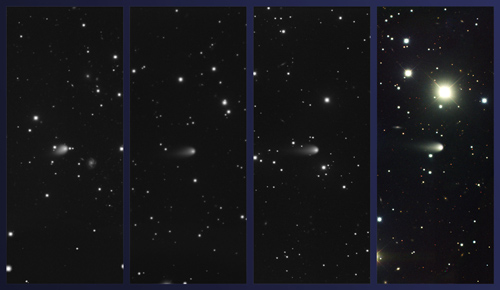
Images of Comet ISON obtained using the Gemini Multi-Object Spectrograph at Gemini North on February 4, March 4, April 3, and May 4, 2013 (left to right, respectively; Comet ISON at center in all images). Credit: Gemini Observatory/AURA.
Watching out for hazards: ESA opens asteroid centre

neo admin
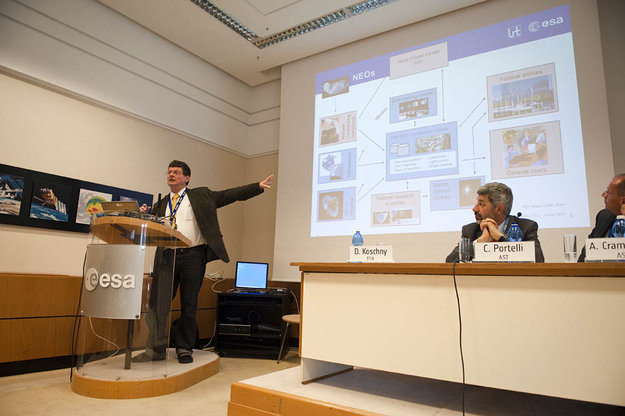
ESA today inaugurated a new hub that will strengthen Europe's contribution to the global hunt for asteroids and other hazardous natural objects that may strike Earth.
Near-Earth Objects, or NEOs, are asteroids or comets with sizes ranging from metres to tens of kilometres that orbit the Sun and whose orbits come close to that of Earth. There are over 600.000 asteroids known in our Solar System, and almost 10.000 of them are NEOs.
Dramatic proof that some of these could strike Earth came on 15 February, when an unknown object thought to be 17–20 m in diameter exploded high above Chelyabinsk, Russia, with 20–30 times the energy of the Hiroshima atomic bomb. The resulting shock wave caused widespread damage and injuries, making it the largest known natural object to have entered the atmosphere since the 1908 Tunguska event.
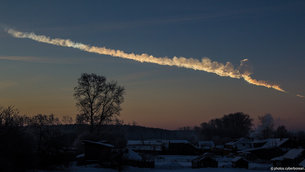
The NEO Coordination Centre will serve as the central access point to a network of European NEO data sources and information providers being established under ESA's Space Situational Awareness (SSA) Programme.
This is the second centre to be opened under SSA leadership after the Space Weather Coordination Centre that opened in Brussels last month.
Located at ESRIN, ESA's centre for Earth observation, the centre was formally inaugurated today by Thomas Reiter, ESA Director of Human Spaceflight and Operations, together with Augusto Cramarossa, Italian Delegate to the ESA Council, and Claudio Portelli, Italian Delegate to the SSA Programme, both of ASI, the Italian space agency.
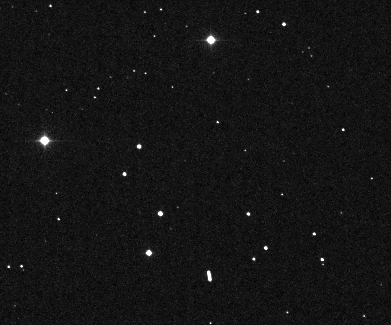
The event was hosted by Volker Liebig, ESA Director of Earth Observation Programmes and Head of the ESRIN Establishment.
The new centre will support experts in the field by federating new and existing European assets, systems and sensors into a future NEO system. It will support the integration and initial operation of ESA's NEO information distribution network (on the left - Asteroid 2012DA14).
The Centre is also the focus point for scientific studies needed to improve NEO warning services and provide near-realtime data to European and international customers, including scientific bodies, international organisations and decision-makers.
